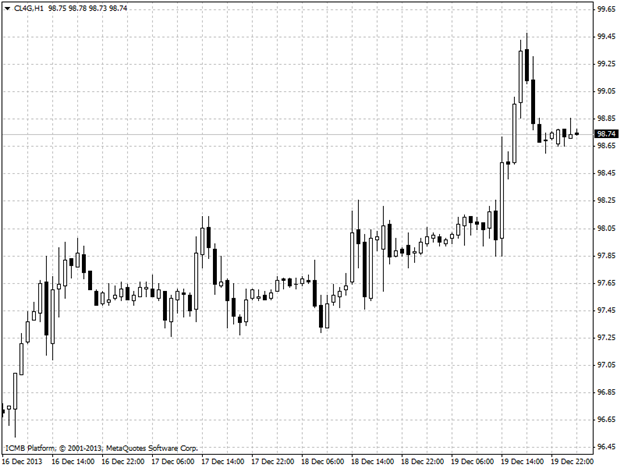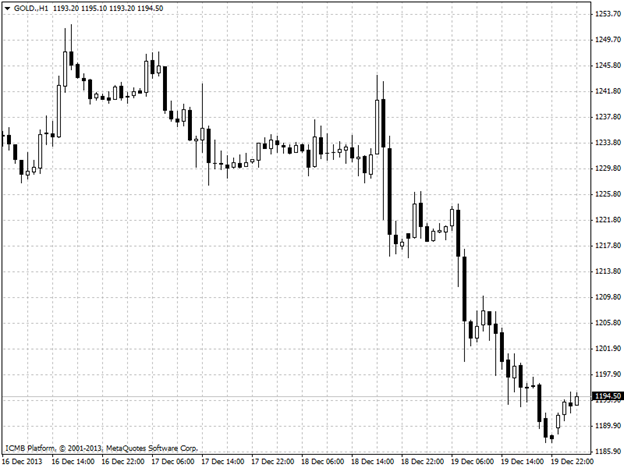CL
Oil prices rose in early afternoon trading on Thursday on expectations that the Federal Reserve's decision to trim its monthly USD85 billion asset-purchasing program will herald the arrival of a more robust U.S. economy, one that will demand more fuel and energy going forward. Crude gains on expectations for a more robust U.S. economy The Fed said on Wednesday it was cutting its bond-buying program to USD75 billion a month from USD85 billion. Asset purchases weaken the greenback by driving down interest rates, making oil an attractively-priced commodity on dollar-denominated exchanges as long as they are in effect. Despite the tapering of bond purchases, the Fed added it was keeping overall monetary policy accommodative for some time to come, which gave oil a boost on Thursday, especially as hopes for a robust 2014 economy began to grow. Elsewhere, sluggish economic indicators met a muted response in energy markets. The Federal Reserve Bank of Philadelphia said that its manufacturing index jumped to 7.0 for December from November’s 6.5 reading, though analysts were expecting the index to rise to 10.0 this month.
GOLD
Gold prices dropped on Thursday in wake of the Federal Reserve's Wednesday announcement that it will trim its USD85 billion in monthly bond purchases by USD10 billion beginning in January. Gold drops on Fed decision to taper bond-buying program Bond purchases seek to boost recovery by pushing down interest rates, weakening the dollar in the process and making gold an attractive hedge. Gold took a dive after the Fed on Wednesday announced that it would reduce its USD85 billion-a-month bond-buying program by USD10 billion in January. Fed bond purchases, in effect for 15 months now, have supported gold by bolstering its image as a hedge to the dollar's weakening trend that comes with monetary intervention in the economy. Meanwhile, less-than-stellar economic indicators in the U.S. watered down the greenback's gains, though they did little to boost demand for the yellow metal. Also on Thursday, the U.S. Department of Labor said the number of individuals filing for initial jobless benefits in the week ending Dec. 14 increased by 10,000 to a seasonally adjusted 379,000, the highest level since March.
- English (UK)
- English (India)
- English (Canada)
- English (Australia)
- English (South Africa)
- English (Philippines)
- English (Nigeria)
- Deutsch
- Español (España)
- Español (México)
- Français
- Italiano
- Nederlands
- Português (Portugal)
- Polski
- Português (Brasil)
- Русский
- Türkçe
- العربية
- Ελληνικά
- Svenska
- Suomi
- עברית
- 日本語
- 한국어
- 简体中文
- 繁體中文
- Bahasa Indonesia
- Bahasa Melayu
- ไทย
- Tiếng Việt
- हिंदी
Friday's Oil And Gold
Published 12/20/2013, 04:40 AM
Updated 04/25/2018, 04:40 AM
Friday's Oil And Gold
Latest comments
Loading next article…
Install Our App
Risk Disclosure: Trading in financial instruments and/or cryptocurrencies involves high risks including the risk of losing some, or all, of your investment amount, and may not be suitable for all investors. Prices of cryptocurrencies are extremely volatile and may be affected by external factors such as financial, regulatory or political events. Trading on margin increases the financial risks.
Before deciding to trade in financial instrument or cryptocurrencies you should be fully informed of the risks and costs associated with trading the financial markets, carefully consider your investment objectives, level of experience, and risk appetite, and seek professional advice where needed.
Fusion Media would like to remind you that the data contained in this website is not necessarily real-time nor accurate. The data and prices on the website are not necessarily provided by any market or exchange, but may be provided by market makers, and so prices may not be accurate and may differ from the actual price at any given market, meaning prices are indicative and not appropriate for trading purposes. Fusion Media and any provider of the data contained in this website will not accept liability for any loss or damage as a result of your trading, or your reliance on the information contained within this website.
It is prohibited to use, store, reproduce, display, modify, transmit or distribute the data contained in this website without the explicit prior written permission of Fusion Media and/or the data provider. All intellectual property rights are reserved by the providers and/or the exchange providing the data contained in this website.
Fusion Media may be compensated by the advertisers that appear on the website, based on your interaction with the advertisements or advertisers.
Before deciding to trade in financial instrument or cryptocurrencies you should be fully informed of the risks and costs associated with trading the financial markets, carefully consider your investment objectives, level of experience, and risk appetite, and seek professional advice where needed.
Fusion Media would like to remind you that the data contained in this website is not necessarily real-time nor accurate. The data and prices on the website are not necessarily provided by any market or exchange, but may be provided by market makers, and so prices may not be accurate and may differ from the actual price at any given market, meaning prices are indicative and not appropriate for trading purposes. Fusion Media and any provider of the data contained in this website will not accept liability for any loss or damage as a result of your trading, or your reliance on the information contained within this website.
It is prohibited to use, store, reproduce, display, modify, transmit or distribute the data contained in this website without the explicit prior written permission of Fusion Media and/or the data provider. All intellectual property rights are reserved by the providers and/or the exchange providing the data contained in this website.
Fusion Media may be compensated by the advertisers that appear on the website, based on your interaction with the advertisements or advertisers.
© 2007-2024 - Fusion Media Limited. All Rights Reserved.
